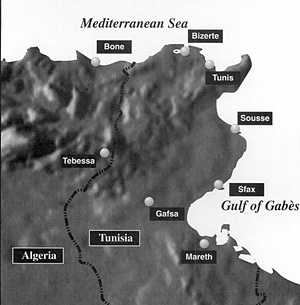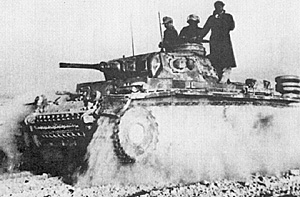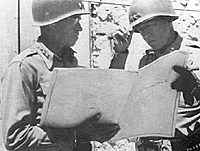 At the retreat last September, I unveiled two prototypes of Tunisia for their first play-throughs. Tunisia is the third OCS game. It covers the end of the war in Africa (Nov. '42-May '43), and we will release it at Origins 1995. Between the two games, about 10 players engaged in four runs of the campaign game. These games proved the OCS robust enough to handle the new theater well. There were two Allied victories, one Axis victory, and one incomplete.
At the retreat last September, I unveiled two prototypes of Tunisia for their first play-throughs. Tunisia is the third OCS game. It covers the end of the war in Africa (Nov. '42-May '43), and we will release it at Origins 1995. Between the two games, about 10 players engaged in four runs of the campaign game. These games proved the OCS robust enough to handle the new theater well. There were two Allied victories, one Axis victory, and one incomplete.
The number of resulting glitches and first-play corrections was surprisingly small. This is a good sign since I made these tests the first playings of the game. Only a handful of people had even seen Tunisia set up; no one had ever moved a counter in the game and no one knew what to expect. I was trying to avoid the trap several playtesters of EatG fell into-stereotyped play.
We did not have that problem. From the start, the game I played in was a series of rapid actions and a roller-coaster ride of excitement. Each turn was a surprise, and the morale of both sides shot up and down with manic frequency. More than one tester said, "That was the best game I've played in years..." And that had everything to do with the wide-open, wild nature of the beast-as well as the "conservative" play of one Boyd Schorzman. Wow!
The Battleground
 Tunisia does a number of things we have not yet seen in OCS games. First, it allows a look at an "undeveloped" theater: a theater of war with no build-up of troops and no pre-loaded front lines or friendly territory. You get to establish that yourself-and it is very interesting.
Tunisia does a number of things we have not yet seen in OCS games. First, it allows a look at an "undeveloped" theater: a theater of war with no build-up of troops and no pre-loaded front lines or friendly territory. You get to establish that yourself-and it is very interesting.
PzIII rolling across the desert.
It is the first OCS game with truly rugged terrain. This adds a new dimension to the series for those used to the flat terrain of Russian steppe. Terrain analysis becomes very important. Players learn to deal with situations made more interesting due to the effects of terrain. The idea of dealing with critical hexes adds to the system's depth concerning the effects of maneuver.
Tunisia is also more manageable in size than earlier OCS games and a perfect introduction for those put off by its larger cousins. Better yet, they may well find that the OCS is not as "complex" as some portray it. They might be emboldened to give the bigger games a shot and find out how much fun Enemy at the Gates can be. For others who just do not have time or space for the bigger ones, it will be ideal. The small numbers of units (at start and later) make for a fast moving, wide open game in which anything can and does happen.
The game begins with the legendary "race for Tunis"; fresh from the success of Torch, the Allies try to seize Tunisia quickly. The Axis begins a massive troop build-up to assist the tiny forces already on hand. The Axis player acts as a major level planner in the buildup. He can directly influence the order in which the units come on as well as the amount of supply shipped in relation to the amount of units. Balancing SPs versus units (as well as type of units) allows the player to develop the theater to his liking.
The Combatants
The remnants of the Deutches Afrika Korps (DAK) are withdrawing across Libya toward Tunisia. One of the Axis player's major concerns is the preparation of his fledgling theater to absorb them. This means saving precious replacement units to rebuild the shattered units of DAK and hoarding SPs to fuel its attempt at a major counterstroke later in the game.
Following DAK onto the map is Montgomery's 8th Army. A variable number of turns after DAK's appearance on the map, Monty will cross onto the map edge to deal with the Mareth Line and add his punch to the Allied drive on Tunis.
 Patton and Bradley (probably in Sicily)
Patton and Bradley (probably in Sicily)
The 8th Army in the game is at its peak and enters play with some splendid units. It is the opposite of the abysmally green (no pun intended) US army, whose only saving grace is an excellent Ranger battalion (give a vet some leeway with his own) and its exceptional artillery. The US army is weak inaction ratings but impressive in raw combat power-these boys are really mean when they all I get together, in combat mode, where their tanks can have an effect. a few ex-Vichy French units are available, although their equipment is laughable by 1942 standards. The battalions of the Foreign Legion are tough fighters and can add much-needed "smarts" to the bludgeoning American attacks.
On the Axis side, you get the DAK, which is the cream of the crop by this point, and a mixed bag of Italians. Some of those coming from Italy are good, but those boiling out of the desert with the DAK are just plain beat. I came to the conclusion that the Italian army had mostly had it with North Africa at this point and was not interested in being the last to die for useless sand. The Superga Infantry Division is interesting if only because it comes with an unusual complement of Semovente Assault Guns-like StuGs with Italian nameplates. The Germans also get the outstanding, fullstrength, and well rested 10th Panzer Division and the excellent 334th Infantry Division. They get a Kampfgruppe of Brandenburgers, the world's only para-mech -engineer battalion, several decent FJ units, and a great air force. (This will be one of the few times the Americans have to operate without air superiority-an unusual experience for them!).
The Surprises
For series pros, there will be a few other twists. for the first time, both sides can do air drops-although their utility remains in doubt according to the playtesters. In GB, the Russian air force is almost useless against a skilled German; in Tunisia, either air force can be a contender (some units of both sides can do Hip Shoots, another first)-so careful air campaigning on both sides is interesting. The small number of troops available means tactical handling of small actions is paramount and the positioning and mode of each unit becomes very important. There just aren't enough units to do everything.
The final layout of scenarios is not complete but there will be small scenarios that deal with each action of the campaign as well as numerous campaign starts. Get ready for the time of your life!
Back to Table of Contents -- Operations #17
Back to Operations List of Issues
Back to MagWeb Master List of Magazines
© Copyright 1995 by The Gamers.
This article appears in MagWeb (Magazine Web) on the Internet World Wide Web.
Other military history articles and gaming articles are available at http://www.magweb.com